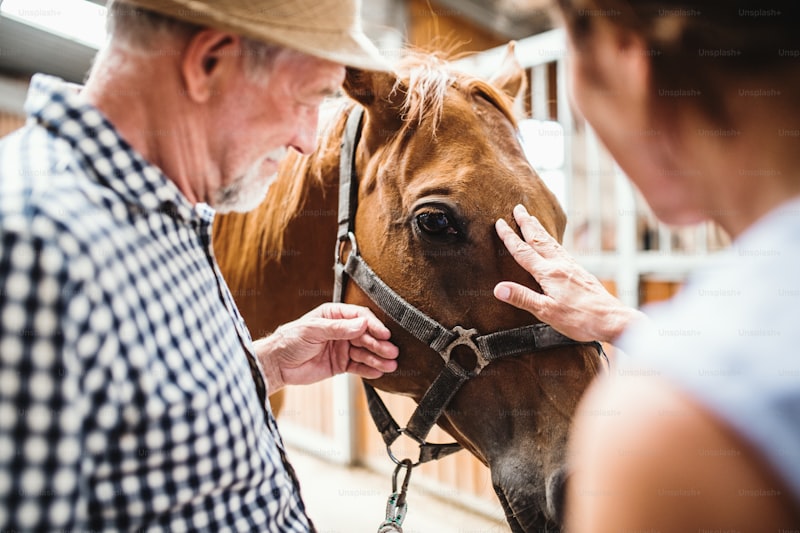One of the primary benefits of horse therapy is its physical impact. Interacting with horses requires physical engagement such as grooming, riding, or simply being around these majestic animals. These activities promote muscle strength, coordination, and balance improvement. For individuals with physical disabilities or those recovering from injuries, the rhythmic motion of horseback riding can stimulate core muscles and enhance flexibility.
Emotionally, horse therapy provides a nurturing environment that encourages trust and empathy. Horses are incredibly perceptive creatures, capable of sensing human emotions and responding in kind. This sensitivity creates a non-judgmental space where individuals can freely express themselves without fear of criticism. The bond formed with a horse can foster a sense of companionship and boost self-esteem, particularly beneficial for those struggling with anxiety, depression, or trauma.
Moreover, horse therapy has profound mental health benefits. The serene environment of a stable or a riding arena offers a therapeutic escape from the stresses of daily life. Engaging with horses releases endorphins and reduces cortisol levels, promoting relaxation and emotional balance. For individuals coping with PTSD or behavioral issues, interacting with horses can help manage symptoms and develop coping mechanisms.


In summary, horse therapy transcends traditional therapeutic methods by incorporating the healing power of human-animal interaction. Whether through physical exercises, emotional bonding, or mental rejuvenation, this holistic approach fosters profound benefits for individuals of all ages and backgrounds. As more research explores its therapeutic potential, horse therapy continues to emerge as a valuable adjunct to conventional treatment modalities, offering hope and healing through the gentle presence of these extraordinary animals.
Healing Hooves: Exploring the Transformative Benefits of Horse Therapy

Have you ever experienced the soothing power of a gentle touch or the calming effect of a warm embrace? Imagine now, the serene presence of a majestic horse, offering not just companionship but also profound emotional healing. This is the essence of horse therapy, where these magnificent creatures play a pivotal role in transforming lives.
Horse therapy, often referred to as equine-assisted therapy or hippotherapy, harnesses the innate connection between humans and horses for therapeutic purposes. It goes beyond traditional methods by utilizing the horse’s movements, demeanor, and even its warmth to facilitate emotional growth and healing.
One of the most remarkable aspects of horse therapy is its ability to break down emotional barriers. Horses, known for their sensitivity and non-verbal communication skills, can intuitively sense human emotions. They respond to our feelings with empathy, providing a safe space for individuals to explore their emotions without fear of judgment.
Moreover, the physical aspect of horse therapy offers significant benefits, especially for those with physical disabilities or injuries. The rhythmic motion of riding a horse stimulates core muscles, improves balance, and enhances coordination. This physical engagement not only aids in rehabilitation but also boosts self-confidence and independence.
Beyond the physical and emotional benefits, horse therapy fosters a sense of responsibility and trust. Caring for a horse requires patience, consistency, and respect, qualities that translate into everyday life. For many participants, this newfound sense of responsibility becomes a cornerstone of personal growth and development.
Horse therapy stands as a testament to the profound bond between humans and animals. It is a therapeutic journey where healing happens hoof by hoof, offering hope, strength, and transformation to all who embark on it.
From Stable to Serenity: How Horse Therapy Soothes Mind and Body
Horse therapy, also known as equine-assisted therapy, harnesses the unique bond between humans and horses. These majestic animals have an innate ability to sense emotions and respond with empathy, making them ideal partners in the healing process. As you interact with them—grooming, leading, or simply being near them—their rhythmic movements and tranquil demeanor can have a profound effect on your mood and stress levels.
One of the key benefits of horse therapy is its ability to reduce anxiety and promote relaxation. The simple act of being around horses can lower cortisol levels, the hormone responsible for stress. Their steady presence and predictable behavior create a safe environment where you can let go of worries and find a sense of calm.
Moreover, horse therapy is not just about emotional healing; it also offers physical benefits. The movements required during activities like riding or grooming can improve coordination, balance, and muscle strength. This makes it especially beneficial for individuals with physical disabilities or those recovering from injuries.
In essence, horse therapy offers a holistic approach to wellness, addressing both mental and physical well-being in a natural and non-invasive way. It’s like finding a peaceful oasis in the midst of life’s storms—a place where you can reconnect with yourself and find solace in the company of these gentle giants.
Next time you feel the weight of the world on your shoulders, consider the healing power of horses. They may just offer the serenity and tranquility you need to restore your mind and body to harmony.
Gallop to Good Health: Unveiling the Physical Benefits of Equine Therapy
Equine therapy, often known as horse therapy or hippotherapy, isn’t just about horseback riding. It’s a structured approach where horses are used to help individuals with various physical and mental health challenges. From children with autism to adults recovering from injuries, these majestic animals offer a unique form of therapy that goes beyond traditional methods.

One of the most striking benefits of equine therapy lies in its physical effects. Riding a horse requires more than just sitting – it engages muscles throughout the body, from the core to the legs and even the arms. The act of balancing on a moving horse stimulates core muscles, improves coordination, and enhances overall strength. It’s like a full-body workout disguised as a therapeutic session.
Moreover, the rhythmic motion of the horse mimics the human gait, which can be incredibly beneficial for individuals relearning to walk or improving their motor skills. For someone recovering from a stroke or coping with cerebral palsy, these movements can be transformative, helping to rebuild muscle tone and restore mobility.
Beyond the physical benefits, there’s a profound emotional connection that develops between humans and horses. Horses are intuitive animals, sensitive to human emotions. Working with them can boost confidence, reduce stress levels, and promote a sense of calmness and well-being. It’s therapeutic in every sense – mentally, emotionally, and physically.
Imagine the impact of a therapy session where progress isn’t measured just in steps or exercises, but in moments of connection and trust between a person and a horse. It’s a journey where each hoofbeat resonates with healing potential, where challenges are met with encouragement, and where every session brings new discoveries.
Beyond Words: How Horse Therapy Empowers Non-Verbal Communication
In horse therapy sessions, individuals interact with horses under the guidance of trained therapists. These majestic animals are highly attuned to human emotions, reacting to even the slightest changes in mood or demeanor. As participants engage with the horses, they learn to communicate non-verbally, relying on gestures, eye contact, and posture to convey their intentions and feelings.
The therapy sessions provide a safe space for individuals to explore and express themselves without the pressure of verbal communication. Horses, with their gentle yet powerful presence, encourage participants to be present in the moment and to listen to their own emotions as well as those of the horse.
For children with autism spectrum disorders or individuals recovering from trauma, horse therapy can be particularly transformative. The unconditional acceptance and non-judgmental attitude of horses create an environment where trust can flourish. Through grooming, leading, and other activities, participants develop confidence, assertiveness, and empathy, skills that extend beyond the therapy arena into daily life.
Metaphorically speaking, horses act as mirrors, reflecting back the emotions and behaviors of the participants. This reflection helps individuals gain insight into their own non-verbal cues and how these affect their interactions with others. Over time, participants often experience improved self-awareness and a greater ability to navigate social situations with ease.
Harnessing Hope: The Psychological Benefits of Equine-Assisted Therapy
Imagine a therapy session where the soft nuzzle of a horse and the gentle rhythm of its steps replace the conventional therapist’s couch. This is the essence of Equine-Assisted Therapy (EAT), a revolutionary approach gaining traction for its profound psychological benefits. Beyond the serene backdrop of a stable, EAT offers a unique healing experience that blends human interaction with equine companionship.

At its core, EAT leverages the innate connection between humans and horses to foster emotional growth and mental well-being. The therapeutic process involves various activities such as grooming, feeding, and leading horses under the guidance of trained professionals. These interactions are not just about learning horsemanship skills but also about building trust, confidence, and emotional resilience.
One of the key psychological benefits of EAT lies in its ability to provide a non-judgmental environment where individuals feel safe to explore their emotions. Horses, with their sensitive nature and ability to mirror human emotions, become catalysts for self-discovery and healing. This unique bond helps participants develop empathy, improve communication skills, and regulate their emotions effectively.
Moreover, engaging with horses in therapy sessions can significantly reduce symptoms of anxiety, depression, and PTSD. The rhythmic motion of riding a horse, for instance, can have a calming effect on the nervous system, promoting relaxation and stress relief. This holistic approach to therapy addresses not only mental health issues but also physical challenges, making it accessible to a wide range of individuals seeking healing and personal growth.
Equine-Assisted Therapy offers a transformative journey towards emotional well-being through the power of human-horse connections. By harnessing hope and leveraging the profound bond between humans and animals, EAT continues to pave the way for innovative approaches in mental health treatment.
Frequently Asked Questions
How does horse therapy help with emotional well-being?
Discover how horse therapy enhances emotional well-being through structured interactions with horses, promoting relaxation, confidence building, and emotional regulation.
Is horse therapy suitable for children with special needs?
Horse therapy, also known as equine-assisted therapy, can be beneficial for children with special needs. It helps improve coordination, balance, and confidence through interactions with horses. The therapy is tailored to individual needs, promoting emotional well-being and social skills in a supportive outdoor environment.
What are the primary benefits of horse therapy?
Discover the primary benefits of horse therapy with our concise FAQ. Learn how this therapeutic practice promotes physical, emotional, and cognitive well-being through interaction with horses.
What should one expect during a typical horse therapy session?
Discover what to expect during a typical horse therapy session with our concise FAQ. Learn about the therapeutic benefits, session structure, and what participants can experience in a supportive environment guided by trained professionals.
What physical benefits can be gained from horse therapy?
Discover the physical benefits of horse therapy, including improved balance, muscle strength, coordination, and posture. Engaging in therapeutic activities with horses can enhance flexibility and overall physical fitness.


